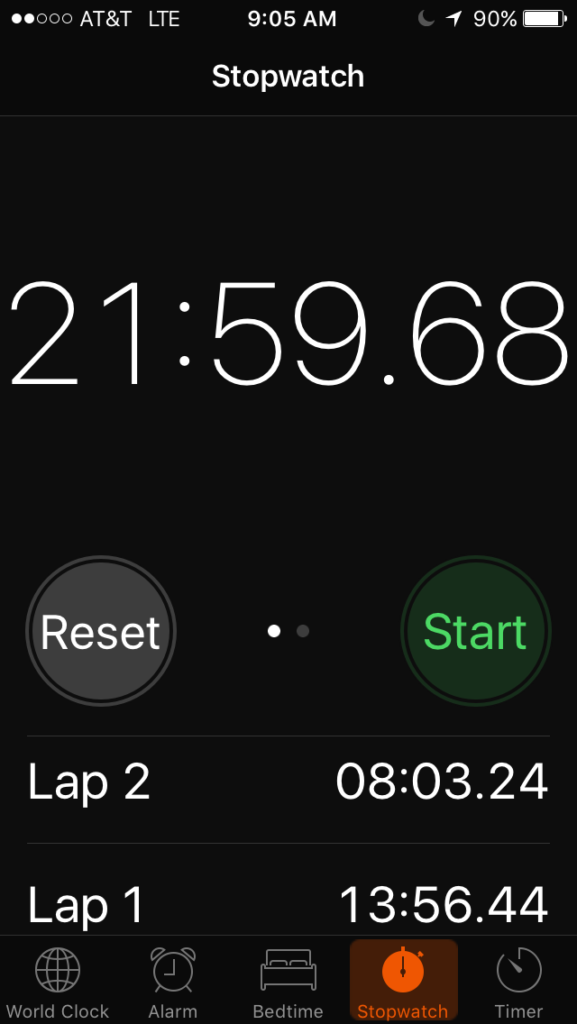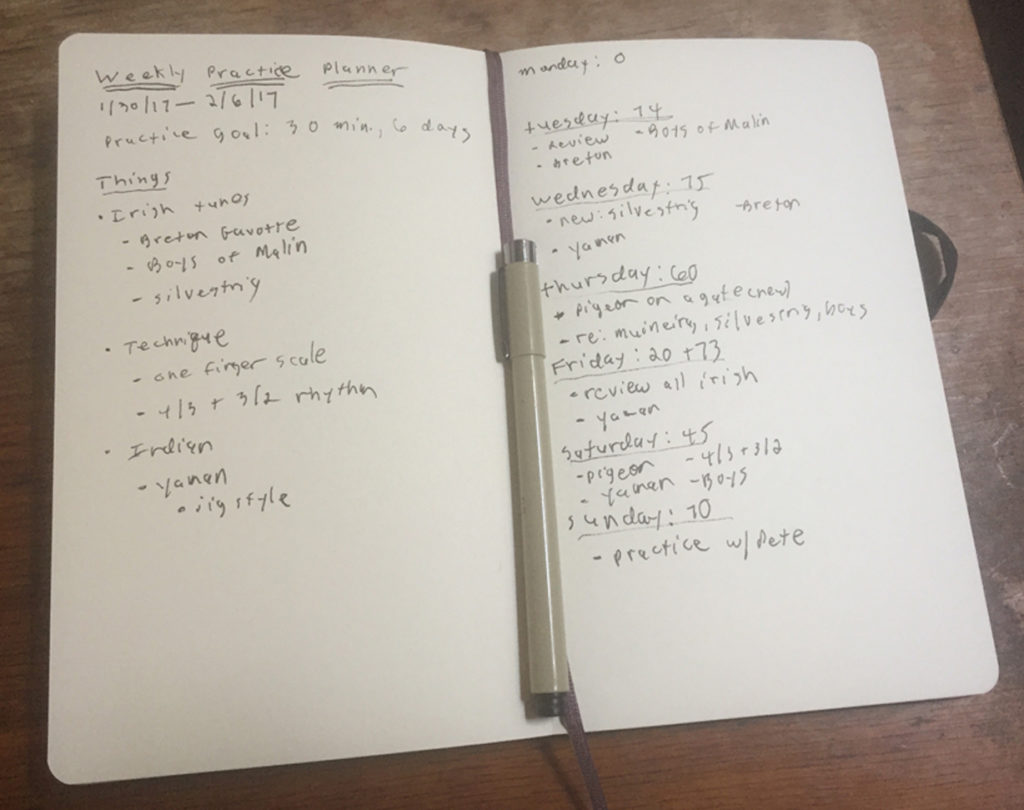One Tune, One Scale, Ten Minutes
How can I make the most of my limited practice time?
Here’s a simple and effective approach to the art of practice: Try organizing your sessions into ten minute blocks in which you do one thing for the whole ten minutes. In the following video I’ll talk about the principle a little and then actually spend ten minutes practicing one tune for ten minutes.
Organizing your practice sessions into ten minute blocks in which you do one thing for the whole ten minutes. It’s a powerful practice tool that’s also a philosophy: Do one thing with your full attention, putting your whole heart and mind into that activity. And it’s easy-to-remember: one tune, one scale, ten minutes. I will abbreviate this as 1:1:10, because I’m a nerd ?
Play one tune for ten minutes. Or one scale for ten minutes. Or one tune and its scale for ten minutes, like Oh Susannah and the D major scale (this is still fairly focused).
Routine
Practice the scale for five minutes.
- Practice Drone tuning
- Or, practice the scale with variations
Practice the tune for five minutes
- Start with the most difficult parts. Play them slowly and then speed up. What are the hard intervals?
- Practice bigger pieces until they flow easily. If they don’t then return to practicing smaller pieces.
Alternate routine
- Practice the scale for roughly 2 minutes, then the tune for two minutes. Continue that way for ten minutes.
- This will really help you to hear the scale in the tune and the tune in the scale.
Tools
Use a stopwatch. I use the one on my iPhone. I like this option because I use the “lap” function. When I hit the “lap” button, it starts a second timer for the new lap while continuing to tally the total time.

This way I can keep track of my total practice time as well as the current ten-minute block.
Another way would be to use a timer set to go off in ten minutes. This is good because you don’t have to be looking over at a clock. You can just play until the alarm goes off.
The low-tech way would be to use a ten minute hourglass. Now that I think about it, that’s a great idea and I want to try it. I think I need to go to HourGlassesForFiddlers.com right now.
See which option works better for you. Let us know about your practice on the FiddleHed Practice Forum.
Process
Before a practice session, take a minute to decide how much time you have and what you want to work on. If you have thirty minutes to practice, then you have three sessions. Write down a 1-5 things you want to practice. Decide what the most important thing is.

Start your timer and begin practicing the most important thing. Refer to the sections of this course for ideas on how to make the practice fun and productive.
At the end of your ten-minute block, take a one-minute break to stretch and assess, even if you don’t think you need or want to do this. If you’re tracking practice with a weekly practice planner or journal, write down what you just did and any observations or things you want to remember. Then decide to stay with that same thing for ten more minutes or move on to something else.
If you’re using a stopwatch, this is when you’d hit the lap button. If using a timer, set it to go off in another ten minutes. If you’re using the hourglass, you will invoke the spirit of Merlin and turn the hourglass upside down.
Focus
You will make much more progress with this approach because you will have focused practice. And I bet you’ll have a better time while you’re at it.
Here’s what my student Sue says about the 1:1:10 practice, “I like playing a tune for a long time because I get better as I go.”

The typical pattern most students have is to play through everything they know once or twice, then stop when they are bored or tired. In this way they just tread water, doing a little of everything, but not getting much better at anything.
Revelations
If you actually play a single tune for ten minutes, things will be revealed. At first, doing one thing for an extended period of time may seem boring. But as you continue, you will say things like, “Oh, it’s hard to go from first finger on A string to the third finger on the D string. I need to practice that.” Then, find different ways to practice A1-D3. Add rhythms like hoedown. Do it with throw-away bow. Do it on other strings. Do the notes surrounding A1-D3 in the part of the tune you were working on, etc.
In this way, the tune will teach you what you need to practice.
In addition to discovering how it might sound better, you will receive ideas about how to be more expressive with the tune, how to add variation. “Whoa. If I slide into D1 in the second quarter it sounds pretty cool.” Playing the tune becomes a process of discovery.
Different Ways to Focus
You can use this approach even if you are practicing something that involves multiple tunes, like creating a set or reviewing previously-learned tunes. If you take ten minutes and review all the tunes you’ve learned in the last three months, then you are completely focused on this one task. If you work on playing a set of Irish reels, then just work on that for ten minutes (focus on transitions).
I can play a tune and its scale for an hour without getting bored. If I have a new technique I’m working on, I can practice it over and over. Then I’d try it out on the tune, then take it away, then bring it back. Then I’d create a loop around a phrase alternating between a basic version and a variation with the technique. Before I know it, an hour has passed.
The Big Picture
One tune, one scale, ten minutes, 1:1:10. A simple and easy-to-remember phrase that is both a practice tool and a philosophy.
Practicing with this approach will help you sound better because you will start to notice more things. Why wait until you’ve been playing ten years to sound good? Sound good right now.
In addition to noticing things in tunes, you will start to notice how you practice: what works, what doesn’t, how you feel. Not only are you a learning a particular tune, you are learning how to practice being more aware. And then it becomes very, very interesting. Every day is different. You do different things, feel differently. You try a new way to do an old thing. Ideas are born. You move forward, backward a little, then forward again.
I call it fun.
Assignment:
For one week, try the one tune, one scale, ten minutes practice at least once a day. Ask yourself: How did it go? Was it boring? Was it fun? Did I learn anything? Did I make more or less progress using this strategy
Extra Credit!
This won’t be counted toward your final grade and won’t go on your transcript.
Pretend that you’re in first grade again. Try singing this jingle/mantra with hand gestures. It will help you remember this powerful practice strategy.
Progress tracking
Two ways I can help you level up your fiddling
- Sign up for the FiddleHed newsletter below.
- Sign up for the Free Two-week Trial. You’ll get full access to all courses and group lessons. Plus, I’ll send you some free lessons tailored to your current skill level.
Thanks for being here 🙏
Return To Top of Module 1.2 >>
Return to Fiddle Questions >>
Leave a Reply
You must be logged in to post a comment.

So much truth. I wish I had been told this stuff a long time ago. I was always told, practice 30 minutes every day, if you want be good. But no direction or focus, other to work on a specific song. Thank you for this!